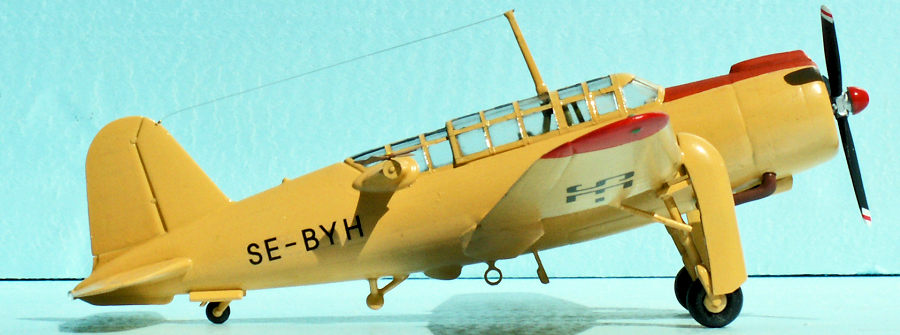
| KIT #: | 3 |
| PRICE: | around $15.00 |
| DECALS: | Twelve options |
| REVIEWER: | Torben Plesberg |
| NOTES: | Short run |

| HISTORY |
For more information on the type see
here . Seventeen B 17 A aircraft were modified as
target tugs, mostly to serve with the Swedish Air Services (Svensk Flygtjänst).
They were civil registered and entered service
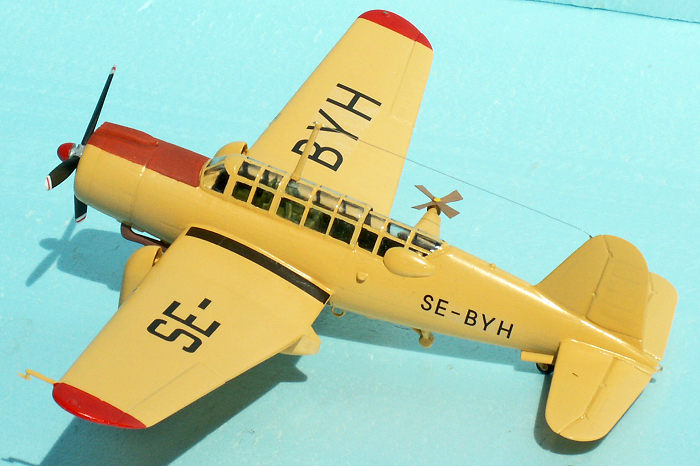 between
1951 and 1954. Two aircraft went to Finland, SH-1 and SH-2, and one went to
Austria 4D-AA. When the SAAB 17 was phased out by Svensk Flygtjänst and replaced
by Fireflies and Skyraiders, three remaining aircraft were operated by Avia at
Visby, Gotland. These three aircraft were the last SAAB 17 A in service in
Sweden, and two of these can still be seen: SE-BWC in Technical Museum at
Elsinore, Denmark. The second aircraft SE-BYH can even be seen in the air.
between
1951 and 1954. Two aircraft went to Finland, SH-1 and SH-2, and one went to
Austria 4D-AA. When the SAAB 17 was phased out by Svensk Flygtjänst and replaced
by Fireflies and Skyraiders, three remaining aircraft were operated by Avia at
Visby, Gotland. These three aircraft were the last SAAB 17 A in service in
Sweden, and two of these can still be seen: SE-BWC in Technical Museum at
Elsinore, Denmark. The second aircraft SE-BYH can even be seen in the air.
This aircraft went to the Flygvapnet Museum, where it was stored for many years, until the Museum decided to restore the aircraft to flying condition. The aircraft was brought back to B 17 A standard Flygvapnet configuration, and it is painted as blue Johan from F 7. In 2005, I had the pleasure to watch the Swedish Stuka in the air piloted by a grey haired ex. B 17 pilot, who had not forgotten how to handle his plane. The B 17 A has its civil registration visible at the tail plane: SE-BYH. This plane is the subject of my model, however, from its time as a target tug with Avia.
| THE KIT |
Comes in
a fairly, large box, which opens in the ends. On the lid, there is a picture
with a couple of Flygvapnet B 17s. In the bottom, there are drawings showing the
color and decaling of some of the options of the kit. On the sides, there are
three further Flygvapnet B 17s and the single Austrian B 17. The instructions is
a single folded A 3 sheet with four A4 pages. Page one gives the history of the
B 17 in Swedish, English and German +
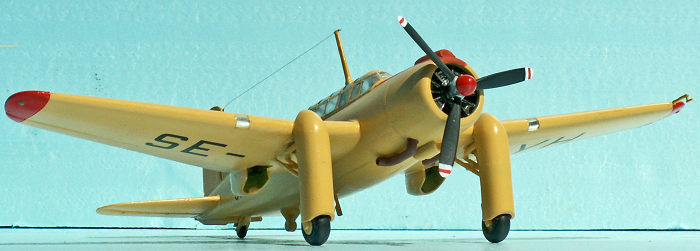 data of
all four versions. Pages two and three show in many exploded sketches how to
assemble the different versions with wheels, skis and floats. Page four, shows
the colors and decaling of six Swedish B 17s – only side views.
data of
all four versions. Pages two and three show in many exploded sketches how to
assemble the different versions with wheels, skis and floats. Page four, shows
the colors and decaling of six Swedish B 17s – only side views.
There are three large sprues, I would call them “double sprues”, in a very light grey styrene, and a small sprue with the clear parts. No wonder that a fairly, large box is needed for a comparatively small model. The parts are mostly clean and without sink marks. The parts fit mostly well together. It is important to study the sketches thoroughly, and decide which version you want to build and take the necessary parts from the sprues to avoid confusion during the construction. The many sketches are actually a bit confusing – too much information on a limited space! However everything is well pondered, it is just a question of understanding the sketches right.
The decal sheet is impressive! There are no less than twelve options: Five for flygvapnet planes, one for each of the following air forces: Imperial Ethiopian AF, Danish AF, Finnish AF, Austrian AF and some target tugs, civil and military. The printing quality is first class, and the decals are easy to apply.
| CONSTRUCTION |
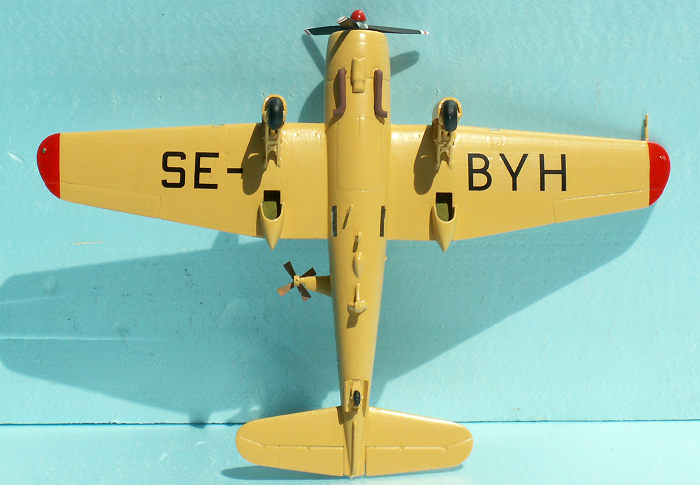 As
mentioned in my former B 17 review, I would like to make another of the many
options of this great kit. In this case, a target tug of Avia. Photos of the
actual aircraft showed that the upper ends of the trousers were clearly visible
above the wing. This position is not shown in the instructions – or on the
drawing by Björn Karlström in “Flygplansritningar 3 p. 54. It has probably
something to do with the weight of the aircraft, meaning that the trousers are
visible above the wing, when the tanks of the aircraft are empty, and with full
tanks, the position of the top of the trousers is at the horizontal center of
the wing. Since it was not possible just to move the trousers 4 mm upwards, I
had to cheat, and make them 4 mm longer, just to get what the photos showed me.
As
mentioned in my former B 17 review, I would like to make another of the many
options of this great kit. In this case, a target tug of Avia. Photos of the
actual aircraft showed that the upper ends of the trousers were clearly visible
above the wing. This position is not shown in the instructions – or on the
drawing by Björn Karlström in “Flygplansritningar 3 p. 54. It has probably
something to do with the weight of the aircraft, meaning that the trousers are
visible above the wing, when the tanks of the aircraft are empty, and with full
tanks, the position of the top of the trousers is at the horizontal center of
the wing. Since it was not possible just to move the trousers 4 mm upwards, I
had to cheat, and make them 4 mm longer, just to get what the photos showed me.
Another modification compared to my C model of the Danish brigade in Sweden was a better way to fix the wire antenna above the canopy. The part of the kit (59) cannot be applied as it is, because it will imply a large gap between the fuselage and the canopy. A couple of mm must be sanded away in the top. It is a delicate job to fix the wire to the top of the antenna. The trick can be done with a 0.5 mm tube, inner gauge 0.3 mm and the wire is only 0.1 mm strong.
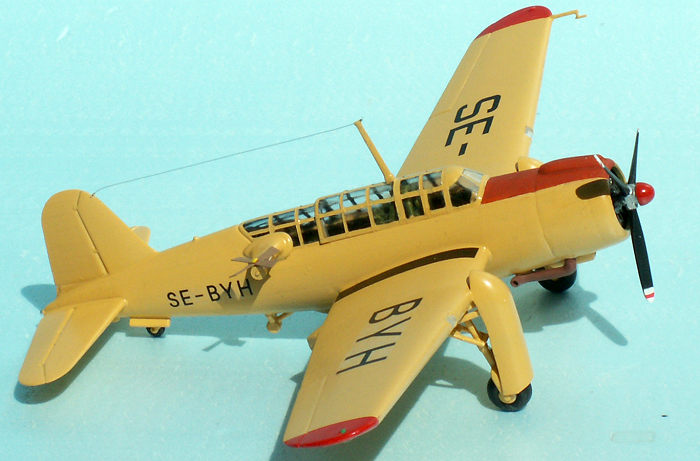 The most
characteristic feature of the target tug is the mill, the propeller driving the
winch for the tug wire. The mill of the kit (part 48) is really too bad, because
it does not at all look like the real thing. I found a way to make a mill that
looks right. From the rim of some photo-etched ship parts, I cut two “double
blades”, 12.5 mm long and about 3 mm wide in both ends. Then I drilled a 0.8 mm
hole in the center of both double blades. Now it was possible to assemble the
mill on a 0.8 mm shaft of brass wire. After the assembly with super glue, the
mill blades were bent a little to become “operative”, and the mill turned nicely
when being blown.
The most
characteristic feature of the target tug is the mill, the propeller driving the
winch for the tug wire. The mill of the kit (part 48) is really too bad, because
it does not at all look like the real thing. I found a way to make a mill that
looks right. From the rim of some photo-etched ship parts, I cut two “double
blades”, 12.5 mm long and about 3 mm wide in both ends. Then I drilled a 0.8 mm
hole in the center of both double blades. Now it was possible to assemble the
mill on a 0.8 mm shaft of brass wire. After the assembly with super glue, the
mill blades were bent a little to become “operative”, and the mill turned nicely
when being blown.
The position of the mill is either horizontal or vertical, when rotating and driving the winch gear. On the model, I found that the horizontal position would be right, as it is when the aircraft is parked on the ground.
| COLORS & MARKINGS |
The overall color
scheme of the B 17 target tug is yellow. Since the color may vary with age and
light conditions, anything between HB 7 light buff and HB 154 insignia yellow,
including HB 24 trainer yellow, may be a good choice. My choice was light buff,
because it is gloss, and therefore provides the best surface for t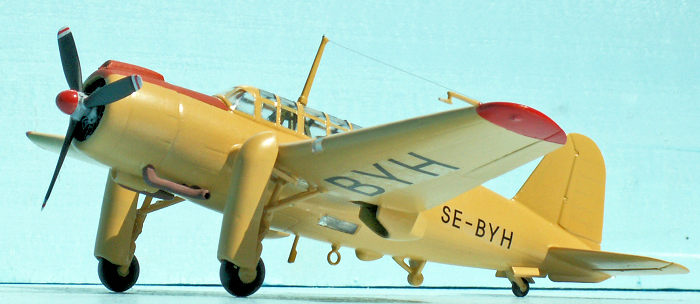 he
decaling. Propeller blades are black with white tips and a red stripe in the
middle. The position lights are the small bulges 3 mm from the wingtips, and
they were colored red and green with Posca pens. The mill is supposed to be a
wood color, HB 110 or similar. The wing tips are red, HB 153 insignia red, and
likewise the front of the spinner. The top of the fuselage in front of the
canopy is red brown, HB 100, and the exhaust pipes are rust colored, HB 113. The
decaling consists of the civil registration letters SE-BYH, which came with the
decal sheet of the kit. Finally, there is a black walkway on either side of the
wing beneath the cockpit. These were made of black decal paper, a sheet of which
I bought in 1962. Since the operator of SE-BYH was no longer Svensk Flygtjänst,
but Avia, the aircraft is without the logo of SF on the fuselage under the
canopy.
he
decaling. Propeller blades are black with white tips and a red stripe in the
middle. The position lights are the small bulges 3 mm from the wingtips, and
they were colored red and green with Posca pens. The mill is supposed to be a
wood color, HB 110 or similar. The wing tips are red, HB 153 insignia red, and
likewise the front of the spinner. The top of the fuselage in front of the
canopy is red brown, HB 100, and the exhaust pipes are rust colored, HB 113. The
decaling consists of the civil registration letters SE-BYH, which came with the
decal sheet of the kit. Finally, there is a black walkway on either side of the
wing beneath the cockpit. These were made of black decal paper, a sheet of which
I bought in 1962. Since the operator of SE-BYH was no longer Svensk Flygtjänst,
but Avia, the aircraft is without the logo of SF on the fuselage under the
canopy.
| CONCLUSIONS |
The Marivox B 17 kit is a short run kit and is good value for money, because of the many options. Actually, I have never seen a kit offering more options than this one, both the kit itself and the decal sheet. The kit is highly recommendable for all modelers who fancy a single engine B 17!
| REFERENCES |
Björn Karlström: Flygplanritningar 3, Swedish Air Force Bombers 1926-86 in scale 1/50 and 1/72. Allt om Hobby, Stockholm 1986. ISBN 91-85496-25-1
My own photos of SE-BWC and SE-BYH
26 November 2019
Copyright ModelingMadness.com
If you would like your product reviewed fairly and fairly quickly, please contact the editor or see other details in the Note to Contributors.
Back to the Main Page Back to the Review Index Page Back to the Previews Index Page